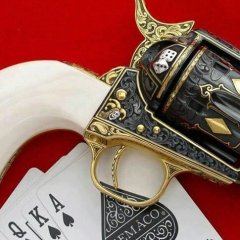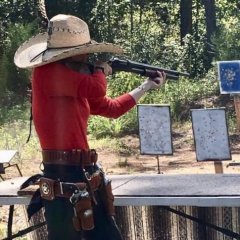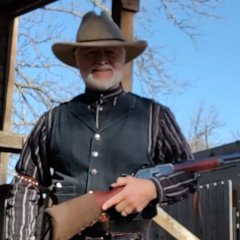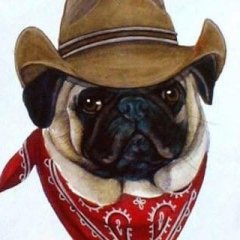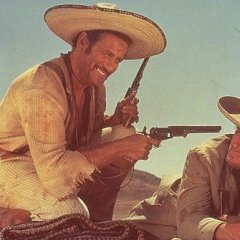-
Posts
11,947 -
Joined
-
Last visited
-
Days Won
5
Garrison Joe, SASS #60708 last won the day on April 23 2018
Garrison Joe, SASS #60708 had the most liked content!
About Garrison Joe, SASS #60708
- Birthday November 30
Previous Fields
-
SASS #
60708 LIFE
-
SASS Affiliated Club
Buffalo Range Riders, Rio Grande Renegades
Profile Information
-
Gender
Male
-
Location
Albuquerque NM
-
Interests
shooting, hiking, hunting, fishing, building, gun smithing, wood working. SASS Regulator. NSCA super veteran.
Recent Profile Visitors
Garrison Joe, SASS #60708's Achievements

SASS Wire Vet (1/1)
6.5k
Reputation
-

Progressive Shot Shell Reloader’s
Garrison Joe, SASS #60708 replied to Lefty Vaquero #39185's topic in SASS Wire
Right in the manual for the 366 are the instructions of how to adjust the auto-advance. The $6 pawl (which is the hand that pushes the shell plate to next station) is replaceable in 5 minutes, as well, when it wears the pawl tip down. I've run Lee whack-a-moles, a Bair, Mecs of several types, an RCBS MiniGrand and now have two Hornady 366s which load up to 2000 rounds a month. Downside - A used 366 will only last you about 50 years (if you don't maintain it). 😄So, hunt down a used one and save $800. Hornady continues to make parts that will be shipped to you in 3 days to fit any 366 ever made. It's so hard to compare the customer service on the 366 to other machines due to the longevity of that 366 model soldiering on with minimal parts required. All progressives have a learning curve. Most progressives need careful adjustment periodically. Put a spilled shot and powder collection pan under ANY progressive you use. You will thank yourself many times over. I find the 366 to be the simplest progressive to run and to adjust. And, adjusted properly, it makes a better-than- factory looking shell. good luck, GJ -

Uberti/cimmaron 1873 reloading help
Garrison Joe, SASS #60708 replied to Bowtie747's topic in SASS Wire
The toggle link rifles "bounce" a feeding cartridge around, since the carrier is more like a tray than a clamp as it moves cartridges from the magazine to the chamber. That lack of positive control means a semi-wadcutter bullet with it's sharp land just behind the nose can catch on the sharp edge of the toggle link guns' chamber. Jam. Now then, a full round nose (RN) bullet, might seem like a great idea, but it can (rarely) result in a round firing in the magazine, if the round tip can contact the primer in the cartridge ahead, and there is some sort of strong jarring motion that builds some inertia in the stack of cartridges. Like dropping a loaded rifle, or letting the Win 1860 rifle's spring loaded cartridge follower loose through carelessness when loading. So, two bullet designs are real practical for toggle link rifles. The Round Nose Flat Point (RNFP) bullet design has a lot of fans. A blunt tip for safety, no sharp land to catch on the chamber. Has been the conventional shape for bullets used in a lever rifle for ages. But, it's got a shorter nose design than the other practical competitor. The Truncated Cone (TC) bullet is the other design that works well. Also has a blunt tip for safety, and no sharp land on the bullet. It can have a longer nose than the RNFP does for the same weight of the slug. Longer nose? Why does someone want that? As bullet weights get driven lighter and lighter (a popular weight now for .38 special is the 105 grain bullet), it becomes necessary to pay attention to the overall length of the loaded cartridge, because each toggle link gun has a minimum length of cartridge that it can feed without jamming. Due to the design of the carrier (and no moving cartridge stops to keep upcoming rounds in the magazine), too short a cartridge length lets one cartridge into the carrier, and part of the second cartridge into the carrier, too. But, shearing a cartridge into two pieces by a carrier which has an upward shear motion as it raises the first cartridge up to the chamber - would be a real bad idea. So, real light bullets benefit from using the TC design since the bullet nose can be tapered more, putting less lead in the nose and more lead in the body of the slug, giving the bullet more length, letting you make a longer cartridge in a .38 special case.. And, the bullet weight you started with, 158 grains, may have been realistic for defense ammunition in revolvers back in the 1920s, but it's way too heavy for use in SASS matches which reward accurate-enough shots fired at maximum rate of fire. A 125 or 105 grain slug makes a lot of sense right now, both in rifles and revolvers. And most bullet casters can supply those. (I assume you are interested in shooting cowboy matches, since you posted to our forum). I'll leave it to others to tell you of suppliers around the Northeast. I'm a "fur piece" from there, and cast my own anyways. good luck, GJ -

Cataract surgery: does it affect shooting?
Garrison Joe, SASS #60708 replied to Tell Sackett SASS 18436's topic in SASS Wire
Depends a bunch on just how bad the right eye is. If you currently can get it "20-20" (or close) with a good lens in your glasses, then you probably can get the right eye surgery to do just as good a job. Ask your Doc who is going to do the lens replacement for sure. If you have astigmatism in one or both eyes, realize that could be corrected with the new implants, but it's about twice as expensive and insurance is reluctant to cover that extra cost. I had cataract surgery, one eye then the other, about 20 years ago. I had both eyes set for close distance because I had been myopic all my life. Now, I wish I had just had distance correction lenses put in. Might have been able to drive and shoot and watch tv without correction, and just use glasses as readers and for computer work. I would not recommend the split distances on the lens settings, it will cut your peripheral vision down. But, I have strong astigmatism in one eye, would not have paid extra for the implants because my history is the astigmatism SHIFTS angle every couple of years, and I still would have needed glasses to shoot and drive even with distance implants put in. Sigh. After surgery, I surely saw better than with the cataracts. Saw COLORS again, too. Unless the surgery goes badly, you will have little problem with any of those activities. Rest up after surgery as prescribed by your surgeon. It IS worth it to find a GOOD cataract surgeon. Not just a small town eye doctor. good luck, GJ -
SAAMI chamber specs show the chamber could be best cut with a 0.459" straight reamer. Technically, the chamber should taper 0.001" to be 0.458" at the mouth of the case. But chamber tolerances would allow up to a 0.463" straight reamer cut. SAAMI handgun specifications; go to page 47 for the dimensional drawings of chamber good luck, GJ
-

Use chamber checkers AND Lee FCDs?
Garrison Joe, SASS #60708 replied to Nostrum Damus SASS #110702's topic in SASS Wire
1 - I run mixed brass in .45 Colt, Cowboy .45 Special, and .45 Auto. I get consistent crimps without being concerned with brass length. When I load a range pickup case and it is so short that a good crimp cannot be made, I knock that round apart and toss that brass that someone cut down into my recycle box. I do limit my range of headstamps in .45 Colt to just Starline, Winchester and Top Brass, due to shorter case life (splits) in many other headstamps, and due to that cartridge being what I shoot out of the lever guns. Back when I loaded .38 Special for a top shooter, I was particular about only a few brands. But for major matches, rifle ammo was made with new Starline cases only, due to the propensity of split .38 Spl cases to either collapse length in the magazine or stick in the chamber. Something you should realize about straight-wall pistol brass - there is not enough chamber pressure and no shoulder/neck cases design to cause brass to grow in length. So, almost all pistol cases are the same length as factory made them, unless someone spent time trimming them. 2 - Overly concerned? As far as I see, ANY concern about pistol case length is unnecessary. good luck, GJ -

Uberti 1873 45 Colt Extractor
Garrison Joe, SASS #60708 replied to Flanigan Flats's topic in SASS Wire
To ensure longer extractor life in that older rifle, I'd put enough bevel into the right side of the barrel slot and/or the right side of the leading edge of the extractor nose. Enough that you don't get contact between the face of the barrel and the extractor. GJ -

Use chamber checkers AND Lee FCDs?
Garrison Joe, SASS #60708 replied to Nostrum Damus SASS #110702's topic in SASS Wire
THAT is the reason that I gave up using FCD dies to crimp when loading straight-wall rimmed cartridges on 550. I use a combined seat/crimp die at last station, and a powder drop checker in station 3. I have given up doing any check on loaded straight-wall rimmed cartridges other than just a wipe-down and visual check for lead shaving or split cases or high primers. With the neck expander at the powder drop die set properly, and care taken to get all the base of a slug into the expanded bell when placing the slug, and keeping the seat/crimp die adjusted and clean of crud, the 550 turns out an extremely low number of rounds that will not chamber in a 73 rifle. Maybe get one failure to chamber in the every 5th year. Yep, very low failure rate. Where loaded round checking is important to me (like for any ammo going into a semi-auto firearm), I check every round in a loaded round gauge. good luck, GJ -

Rossi R92 Front Sight Replacement
Garrison Joe, SASS #60708 replied to Calico Jack's topic in SASS Wire
I like a buckhorn rear sight (the one that came from factory) that is ground / filed down to remove the horns and leave the sight notch. If the notch is hard to find when sighting after that dehorning, then enlarge the notch with a needle file. The measurement of a front sight with dovetail mount base is made from the bottom of the dovetail to the top of the sight (bead). If you can adjust your current rear sight now to hit dead on at 20 yards, then duplicating your current front sight height as closely as possible with a new sight will be a great idea. Does not have to be an exact match, as your current rear sight probably has an adjustment slide on it to vary the rear sight blade height to get you on target. Put a caliper (any type will work) on the front sight (base to bead) after you knock out the front sight, driving it from left side of barrel to right side, using a brass flat-tipped punch. Even with Marble front sights, you normally get a choice of the size of the bead....most cowboy shooters use a large bead size. If this makes you nervous, take to a gunsmith and it's probably 15 minutes max for them to do it if you have the replacement front sight blade. good luck, GJ -

Uberti 1873 45 Colt Extractor
Garrison Joe, SASS #60708 replied to Flanigan Flats's topic in SASS Wire
No, a too-long cartridge OAL (long enough to not chamber fully) will never come up the carrier shaft inside the carrier. The Uberti toggle action acts like a "too-long" cartridge gauge because the carrier shaft in the receiver is almost exactly 1.600" along the length of the opening. Rounds will still feed through the carrier and lift to the chamber up to about 1.595" length (plus or minus for manufacturing tolerances). Only manually dropping a round in the chamber over the top of the carrier (like some folks perform a reload on the line) will let a too-long cartridge get to the chamber. Not sure where you got this "too long" cartridge length in your head, but you need to dismiss that! good luck, GJ -

Who here hunts with BP cartridge?
Garrison Joe, SASS #60708 replied to Sixgun Symphony #62632's topic in SASS Wire Saloon
I've been very successful with BP muzzleloader hunting for deer and elk. Would not even think of hunting with BP pistol caliber cartridges, except in a survival mode. Just my sense of a fair hunt and clean dispatch. GJ -

Uberti 1873 45 Colt Extractor
Garrison Joe, SASS #60708 replied to Flanigan Flats's topic in SASS Wire
You have a suspicion, but at this point not a PROVEN cause of the extractor failures. You have not done some of the standard examinations and tests that could identify the root cause. You are simply jumping on the first thing you could think of. Your "old" ammo load sounds like it is not something most rifles would fail on. If it chambers and fires and extracts for a while with a new extractor, but problems develop after a thousand or so rounds, think more along the lines of double clutching the lever, jumping the trigger to fire just out of battery, or some other functional stress you are creating. If you have disabled the trigger safety and shoot real fast, I'd re-enable the trigger safety. There's lots of possibilities. If you want to improve your success running the gun without having lots more extractor problems than other shooters, dig deep enough to find the root cause. good luck, GJ -

Uberti 1873 45 Colt Extractor
Garrison Joe, SASS #60708 replied to Flanigan Flats's topic in SASS Wire
Perhaps the extractor is being permanently stretched out (up away from bolt) by some sort of collision or cartridge overpressure, so that it loses it's tension. Light loads common to CAS would not damage the extractor. Really heavy (over SAAMI pressure) could. A "wild shot" here - Any chance of temps over 1000 F on the extractor - also would cause loss of spring tension. You are encountering something that normally does not happen. If you do not have the experience to do the visual check of operation I mentioned above, then it's time for at least one gun and some of your (old) ammo to go to a good cowboy gunsmith. If you suspect the old ammo did damage to several extractors, I sure would want to confirm WHAT about the ammo was damaging to your extractors. Otherwise, it may continue to bite you. good luck, GJ -

Uberti 1873 45 Colt Extractor
Garrison Joe, SASS #60708 replied to Flanigan Flats's topic in SASS Wire
First, what do you mean by "eating extractor" - it goes weak, it breaks (if so, show us a picture), or some other problem? How much tension on the extractor hook are you setting (by thinning the spring arm on the extractor during installation}? Can you slip a thin wire with a loop tied in both ends - one end caught on the hook and the other end on a trigger pull gauge. Then pull up until extractor comes up out of the groove like it's ready to snap over the rim of a cartridge. 4-5 pounds of pull to get to that point would be about right, lighter probably means you are thinning the new extractor arm too much. Lots of pressure needed - probably means extractor tip can be stabbing into the back of the round you are chambering, rather than snapping up over the rim. I can feel as I pull up on extractor tips - when they have enough tension they just start to hurt my fingertip as much as I can handle, that seems to be the right tension. I normally get 20,000 rounds of life before the extractor weakens from use enough to need to be replaced (and that's in 45 Colt or 44-40 rifles). And I've never really broken one. Usually a real close visual observation of how the extractor is functioning during feed and extraction will let you find the problem. Time to get a couple of dummy rounds and a cool drink and work the action until you spot problem. Watch for collision of the nose with the base of the round, tight fit of the extractor nose into the relief cut in the barrel, tight fit over the rim of the cartridge resulting in extractor not snapping down in the extractor groove of the cartridge, etc. I run 1.560 to 1.580" rounds all the time in my three .45 Colt 1873 rifles. It's not the length causing problems. good luck, GJ -

but then im old I'm a bit lost about the rules
Garrison Joe, SASS #60708 replied to Cheyenne Ranger, 48747L's topic in SASS Wire
I've seen fund raisers to help a family after a member's death or catastrophic illness, to help rebuild a SASS club property after wind storms and floods, and similar efforts. If it is directly benefiting one or more members to participate in the sport, I'd consider that allowed. But, I'd suggest you check with World Headquarters office before you publicly post up any request for financial help from members, since, of course, it IS their forum. good luck, GJ -
Wipe dust and dirt off. If really mud-caked, toss those in a mesh laundry bag and slosh around in a wash tub of warm water. They really don't need a lot of attention because the sizing dies in a shotshell loader touch just the head cover (what used to be called the brass) of the hull. Never load hulls with moisture inside - you WILL get some squibs from that. While checking them for "clean enough," do keep an eye out for split hulls or petals burnt, crunchy, crispy and having splits and tears at the folds - those do not crimp securely and should be tossed out. And watch for trash down inside the hull. I have found foam ear plugs, chewing gum, rocks, feathers, .22 cases, etc - all of which are bad news if loaded over. good luck, GJ

